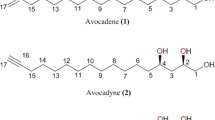Abstract
—A chromatographically enriched fraction designated Fraction B from dry fruits of the plant Melia volkensii (family Meliaceae) was evaluated with the objective of determining its toxic and growth inhibiting effects on the larvae and adults of Culex quinquefasciatus mosquitoes. The fraction was purified from a crude methanolic extract by cold precipitation and elution of the precipitate dissolved in a hexane-ethyl acetate solvent system through a silica gel column. Larval treatments involved rearing the larval stages in water containing the fraction at concentrations of between 5 and 200 ppm. The LC50 for this fraction was found to be 34.72 μ/ml in 48 h. Second instar larvae were found to be more susceptible to fraction B when compared to fourth instar larvae. All fourth instar larvae that survived the treatment moulted into larval-pupal intermediates that were short-lived. The extract was also found to be an oviposition deterrent at a concentration of 20 ppm and above. It is concluded that M. volkensii extract has potential in the control of Culex quinquefasciatus.
Résumé
—Une fraction enrichie chromatographiquement et designée Fraction B des fruits secs de la plante Melia volkensii (famille Meliaceae) a été évaluée pour déterminer sa toxicité et ses effets inhibiteurs de croissance sur les larves et adultes de Culex quinquefasciatus. La fraction a été purifiée à partir de l’extrait méthanolé brut par précipitation à froid et elution du précipité dissoit dans un mélange de solvent hexane-ethyl acetate à travers une colonne de silica gel. Des traitements destinés aux larves impliquaient l’élevage des stades larvaires dans le l’eau contenant la fraction aux concentrations comprises entre 5 et 200 ppm. La DL50 pour cette fraction a été de 34.72 μg/ml en 48 heures. On a trouvé que les larves du 2nd instar ont été les plus susceptibles à la fraction B, comparées aux larves du 4ème instar. Toutes les larves du 4ème instar qui ont survécu au traitement ont mué en intermédiares larve-pupe dont la durée de vie a été écourtée. L’extrait s’est aussi révelé un dissuadant de l’oviposition à la concentration de 20 ppm et au dessus. On en a conclu que l’extrait de M. volkensii offre un moyen potentiel de lutte contre Culex quinquefasciatus.
Similar content being viewed by others

References
Al-Sharook Z., Balan K., Jiang Y. and Rembold H. (1991) Insect growth inhibitors from two tropical Meliaceae. Effect of crude seed extracts on mosquito larvae. J. Appl. Entomol. 111, 425–430.
Finney D. J. (1971) Probit Analysis, Third edition. Cambridge Univ. Press.
Hsieh M. Y. and Steelman C. D. (1974) Susceptibility of selected mosquito species to five chemicals which inhibit insect development. Mosq. News 34, 278–282.
Mwangi R. W. (1982) Locust antifeedant activity in the fruits of Melia volkensii. Entomol. Exp. Appl. 32, 277–280.
Mwangi R. W. and Kabaru J. M. (1991) Insect antifeedant and growth regulator compounds in different parts of Melia volkensii. In 4th Napreca Symposium on Natural Products. Extended abstracts. Addis Ababa, Ethiopia, pp. 13–14.
Mwangi R. W. and Mukiama T. K. (1988) Evaluation of Melia volkensii extract fractions as mosquito larvicides. J. Am. Mosq. Control Assoc. 4, 442–447.
Mwangi R. W. and Rembold H. (1987) Growth-regulating activity in Melia volkensii extracts on the larvae of Aedes aegypti. In Natural Pesticides from the Neem Tree and Other Tropical Plants (Edited by Schmutterer H. and Ascher K. R. S.), pp. 669–681. Schriffenreice der GTZ, No. 206, Eschborn.
Mwangi R. W. and Rembold H. (1988) Growth-inhibiting and larvicidal effects of Melia volkensii extracts on Aedes aegypti larvae. Entomol. Exp. Appl. 46, 103–108.
Rajab M. S. and Bentley M. D. (1988) Tetranortriterpenes from volkensii. J. Natural Products 551, 640–844.
Rajab M. S., Bentley M. D., Achford A. R. and Mendel M. J. (1988) A new limonoid insect antifeedant from the fruit of Melia volkensii. J. Natural Products 51, 169–171.
Sukumar K., Perich M. J. and Boomar L. R. (1991) Botanical derivatives in mosquito control: A review. J. Am. Mosq. Control Assoc. 7, 210–237.
Zebitz C. P. W. (1984) Effects of some crude and azadirachtin enriched neem Azadirachta indica seed kernel extracts on larvae of Aedes aegypti. Entomol. Exp. Appl. 35, 11–16.
Zebitz C. P. W. (1986) Potential of neem seed kernel extracts in mosquito control. Proc. 3rd Int. Neem Conf., Nairobi, pp. 555–573.
Author information
Authors and Affiliations
Additional information
See Editor’s Note at the end of this issue.
Rights and permissions
About this article
Cite this article
Irungu, L.W., Mwangi, R.W. Effects of a Biologically Active Fraction from Melia volkensii on Culex quinquefasciatus. Int J Trop Insect Sci 16, 159–162 (1995). https://doi.org/10.1017/S1742758400017045
Accepted:
Published:
Issue Date:
DOI: https://doi.org/10.1017/S1742758400017045



